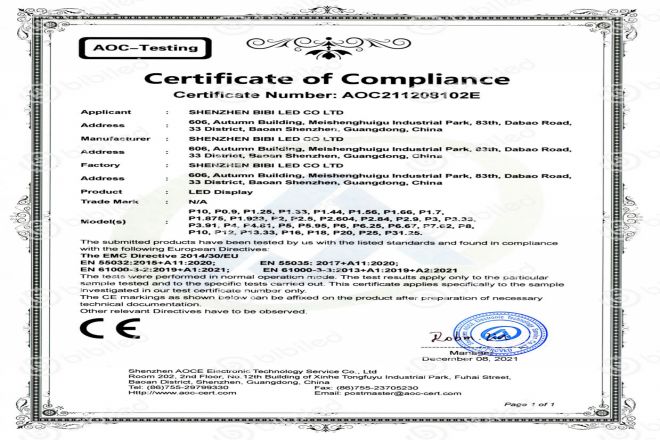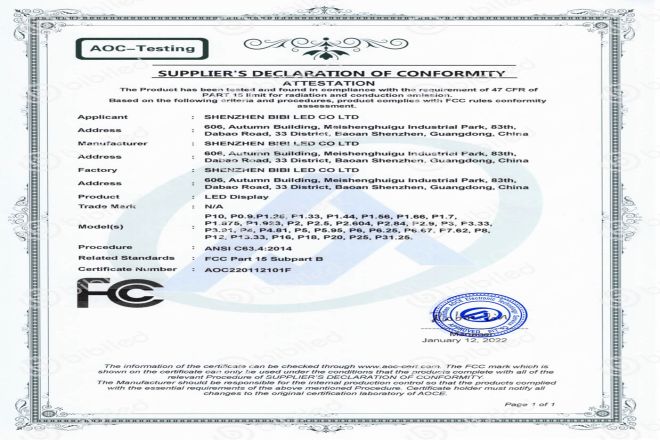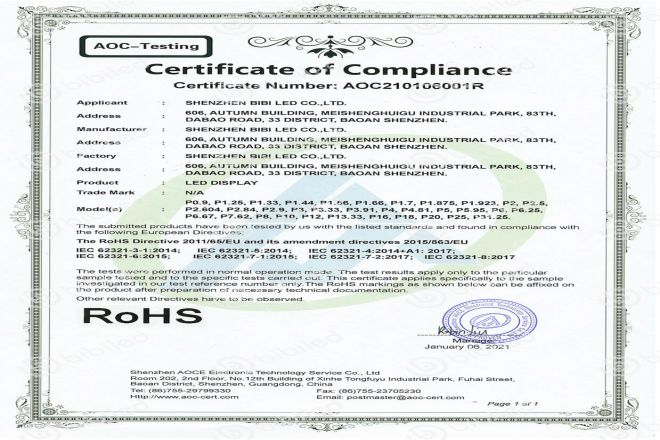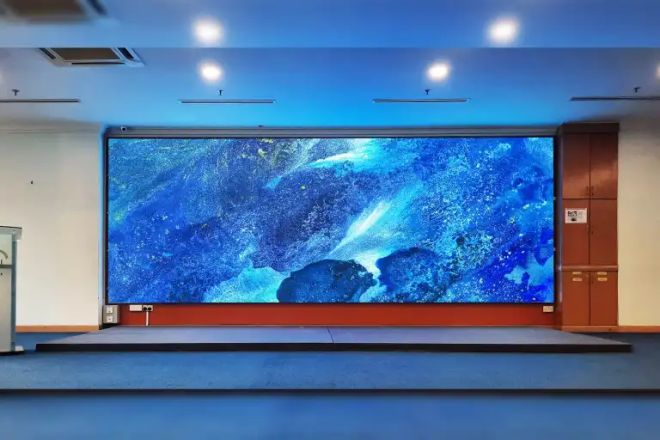Introduction

With the prosperity of the market, product quality, and safety issues have gradually become prominent. In order to ensure the quality, safety, and performance of LED displays, certification is particularly important.
Certification is a process of comprehensive evaluation and testing of LED displays to verify whether the product meets specific standards and requirements.
Certification can ensure that the LED display screen reaches a certain level in terms of quality, safety, performance, etc., thereby protecting the rights and interests of consumers and promoting the healthy development of the market.
1. What are the certifications for LED displays?
As an important carrier of modern information display technology, LED display screens are widely used in many fields, such as business, advertising, media, and sports. In order to ensure its quality and safety, LED displays need to pass a series of certifications.
1). International Certification
- CE certification:

CE certification is a safety certification system implemented by the European Union and is regarded as a passport for manufacturers to open and enter the European market.
For LED displays, CE certification mainly focuses on the electromagnetic compatibility, low voltage directive, machinery directive, etc., of the product to ensure that the product will not cause harm to people and the environment during use.
- FCC certification:

FCC certification is the mandatory certification of electronic equipment by the Federal Communications Commission of the United States. It mainly focuses on whether the electromagnetic radiation of the product exceeds the standard.
Before LED displays can be sold in the US market, they must pass FCC certification to ensure that their electromagnetic radiation complies with relevant US regulations.
- RoHS certification:

RoHS certification is the European Union’s directive to restrict the use of certain hazardous substances in electronic and electrical equipment.
The LED display screen has passed RoHS certification, which means that no harmful substances such as lead, mercury, and cadmium are used in its production process, which complies with environmental protection requirements and helps promote the development of the green electronics industry.
2). China domestic certification
- CCC certification:
CCC certification is China’s compulsory product certification system, involving the safety performance of electronic and electrical products. Before LED displays can be sold in the Chinese market, they must pass CCC certification to ensure that their electrical safety and electromagnetic compatibility comply with relevant Chinese regulations.
- CQC certification:
CQC certification is a certification from the China Quality Certification Center, which mainly certifies product quality, performance, safety, and other aspects. The LED display screen has passed CQC certification, which means that its quality is reliable, its performance is stable, and it can meet customer expectations and needs.
3). Other certifications
- ISO9001 quality management system certification:
ISO9001 is a quality management system standard formulated by the International Organization for Standardization. It requires companies to establish an effective system of quality management to ensure the stability and reliability of product quality.
LED display companies have passed ISO9001 certification, which can prove that they have a complete quality management system and can provide high-quality products and services.
- Energy-saving certification:
Relevant energy-saving certifications are also required for the energy efficiency and performance of LED displays.
These certifications can indicate the energy efficiency level and performance parameters of products, enhance the market competitiveness of products, and help reduce energy consumption and environmental pollution.
- Electromagnetic compatibility (EMC) certification:
Electromagnetic compatibility certification mainly focuses on the mutual influence of equipment in the electromagnetic environment.
As an electronic device, the LED display screen needs to ensure that it does not interfere with surrounding equipment during normal operation, and it must also be able to withstand electromagnetic interference from other equipment.
- Product safety certification:
Product safety certification mainly focuses on the safety issues of LED displays during use, such as fire protection, lightning protection, etc. These certifications ensure that products will not cause harm to people and the environment during use.
2. Can I use an LED display without FCC certification?
LED displays without FCC certification cannot be sold and used in the US market.
FCC certification is the mandatory certification of electronic equipment by the Federal Communications Commission of the United States.
It mainly focuses on whether the electromagnetic radiation of the product exceeds the standard. Before LED displays can be sold in the US market, they must pass FCC certification to ensure that their electromagnetic radiation complies with relevant US regulations.
LED displays without FCC certification may be detained by US Customs and may even face legal penalties.
Therefore, if you plan to sell LED displays in the US market, it is strongly recommended that you obtain FCC certification in advance to ensure product compliance and smooth market entry.
At the same time, you also need to understand and comply with other relevant certification and regulatory requirements to ensure product quality and safety.
3. How do we know whether the LED display screen has passed the certification?

To know whether the LED display screen has passed the certification, you can verify it from the following aspects:
First, check whether there is a certification mark on the product label or related documents.
For example, for CE certification, the product should have a CE mark; for RoHS certification, the product description or related documents should indicate compliance with the RoHS directive; for FCC certification, the product may also have a corresponding certification mark.
Secondly, check the official certification body website. Certification agencies usually publish lists of products or companies that have passed certification. You can enter the model, brand, or manufacturer information of the LED display on these websites to check whether the product has passed relevant certifications.
In addition, contacting manufacturers or suppliers is also an effective way. They should be able to provide detailed information and supporting documentation regarding the product’s certification status.
You can ask them to provide certification certificates, test reports, or other relevant documents to verify whether the LED display has passed the certification.
Finally, for specific certification requirements, such as ISO9001 quality management system certification or energy conservation certification, you can check the official website of the relevant certification agency or government department to understand the specific requirements and processes of certification and judge whether the LED display meets these requirements. Certification standards.
It should be noted that different certification standards and agencies may have different requirements and procedures. Therefore, when verifying whether an LED display has passed certification, you should make sure to understand and follow the relevant certification regulations and processes.
At the same time, certification is only one aspect of product quality and safety. When choosing an LED display, other factors should also be considered comprehensively, such as performance, price, after-sales service, etc.
4. What are the benefits of buying a certified LED display?
Buying a certified LED display has the following benefits:
- Quality Assurance:
Certified LED displays follow strict quality standards and specifications during the production process, thus ensuring product stability and reliability.
The certification process usually includes testing and evaluation of product materials, manufacturing processes, performance, etc., so certified displays have better quality assurance.
- Reliable safety performance:
Certification usually covers the safety performance of the product, such as electrical safety, fire performance, etc. Purchasing certified LED displays can reduce safety risks during use and ensure the safety of personnel and equipment.
- Comply with regulatory requirements:
Countries and regions have corresponding regulatory requirements for electronic products, such as electromagnetic compatibility, environmental protection directives, etc.
Purchasing certified LED displays can ensure that the product complies with the regulatory requirements of the target market and avoid potential risks and losses caused by violations.
- After-sales service support:
Usually, certified manufacturers or suppliers will provide more complete after-sales service support. They are more likely to have a professional technical support team and after-sales service system that can promptly solve problems encountered by users during use.
- Brand image enhancement:
Certification is a recognition of product quality and safety. Purchasing a certified LED display can reflect the professionalism and responsible attitude of the company, helping to enhance the brand image and reputation.
5. How do we ensure that the LED display screen meets certification requirements?

To ensure that the LED display meets the certification requirements, you can proceed from the following aspects:
First, choose a certified manufacturer or brand. When purchasing LED displays, be sure to choose manufacturers or brands that have passed relevant certifications, such as CE, RoHS, FCC, etc.
These manufacturers or brands usually clearly mark certification information on product labels or related documents for consumers to verify.
Secondly, check the product’s certification certificate and test report. Qualified LED displays should have corresponding certification certificates and test reports. These documents can prove that the product has passed the testing and evaluation of relevant certification agencies.
Before purchasing, you can ask the manufacturer or supplier to provide these documents and carefully check the authenticity and completeness of the information.
In addition, it is very important to understand the certification standards and requirements. Different certification agencies and standards may have different requirements and procedures. Therefore, before purchasing an LED display, it is recommended to have a certain understanding of the relevant certification standards and requirements.
In this way, you can better judge whether the product meets the certification requirements and avoid purchasing substandard products.
Finally, relevant regulations and precautions must be followed during installation and use.
Even if the LED display screen has passed the certification, relevant regulations and precautions still need to be followed during installation and use. For example, you should ensure that the display has correct electrical connections and good heat dissipation and avoid use in harsh environments.
This ensures proper operation and extended service life of the display.
Conclusion
Through an in-depth analysis of various certifications for LED displays, it is not difficult to find that certification plays a vital role in ensuring product quality, improving market competitiveness, and safeguarding consumer rights.
Whether it is international certification or domestic certification, they all conduct strict testing and evaluation around product safety, environmental protection, electromagnetic compatibility, quality management systems, and other dimensions.
Finally, if you want to know more about LED display certification, please get in touch with us.
